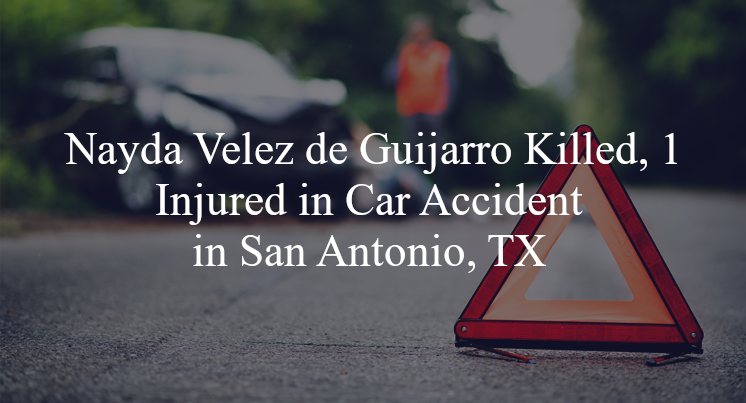Nayda Velez de Guijarro Killed, 1 Injured in Car Accident in San Antonio, TX
San Antonio, TX — May 2, 2025, One person was killed following a car accident that occurred at around 1:35 P.M. on Harry Wurzbach Rd.

An investigation is underway following a car accident that left one person dead and injured another during the afternoon hours of May 2nd. According to official reports, Nayda Velez de Guijarro was traveling as a passenger in a Toyota Tacoma on Harry Wurzbach Road at the Dalewood Place intersection, when it was struck by a speeding Dodge Ram pickup truck.
When first responders arrived on the scene, they found that Guijarro had sustained fatal injuries and she was pronounced deceased, while the driver sustained injuries they were transported to the hospital for treatment. At this time there has been no further information released from the accident, including the status of the driver's injuries or whether any charges or citations will be issued, however this remains an ongoing investigation and more details may be released by authorities in the future.
Commentary
When a collision involves a speeding vehicle and results in the death of one person and injuries to another, especially at an intersection, it’s critical that the investigation not stop at the most visible cause. While speed may clearly be a contributing factor, serious crashes like the one on Harry Wurzbach Road at Dalewood Place must be evaluated through a structured lens. That starts with asking three key questions that provide clarity on how and why the collision occurred—and whether it could have been prevented.
First, did investigators thoroughly analyze the crash scene and traffic environment? Intersections are among the most complex driving environments, and a collision involving a speeding Dodge Ram requires more than just confirmation of excessive speed. Investigators should examine signal timing, lane design, traffic flow, sightlines, and signage. They should also determine whether either vehicle had the right of way, and whether any evasive action was attempted by the Toyota Tacoma or the Dodge Ram. Precise impact angles and physical evidence such as skid marks, point of contact, and vehicle positioning all help build an accurate timeline of the crash.
Second, has anyone evaluated the performance of the involved vehicles’ safety systems, and whether a mechanical failure contributed to the severity of the crash? While excessive speed is a known factor in high-energy collisions, investigators should also examine how the Toyota Tacoma absorbed the impact and whether its restraint systems, including seatbelts and airbags, deployed correctly. Similarly, the Dodge Ram’s braking system, tires, and stability control features should be inspected to determine whether the vehicle was capable of responding properly had the driver attempted to avoid the crash. These questions are especially important when a passenger suffers fatal injuries, as the effectiveness of protective systems becomes central to understanding the crash's outcome.
Third, has all relevant electronic data from both vehicles been collected and analyzed? Both the Tacoma and the Ram are likely equipped with electronic control modules (ECMs), which store critical crash data, including vehicle speed, throttle application, braking input, and steering movements. This data can validate whether the Dodge Ram was indeed speeding at the moment of impact and whether the driver made any effort to brake or swerve. In addition, dash cam footage, surveillance recordings from nearby businesses, or traffic camera video may provide visual context that supports or challenges the electronic evidence.
Crashes that result in fatalities—particularly those involving vulnerable passengers and aggressive driving—demand a complete and transparent investigation. The three questions about the crash environment, vehicle performance, and digital data are not just procedural; they’re essential to delivering the truth to the families involved and ensuring that justice and safety improvements are grounded in fact, not assumption.

*We appreciate your feedback and welcome anyone to comment on our blog entries, however all visitor blog comments must be approved by the site moderator prior to showing live on the site. By submitting a blog comment you acknowledge that your post may appear live on the site for any visitors to see, pending moderator approval. The operators of this site are not responsible for the accuracy or content of the comments made by site visitors. By submitting a comment, blog post, or email to this site you acknowledge that you may receive a response with regard to your questions or concerns. If you contact Grossman Law Offices using this online form, your message will not create an attorney-client relationship and will not necessarily be treated as privileged or confidential! You should not send sensitive or confidential information via the Internet. Since the Internet is not necessarily a secure environment, it is not possible to ensure that your message sent via the Internet might be kept secure and confidential. When you fill out a contact or comment form, send us an email directly, initiate a chat session or call us, you acknowledge we may use your contact information to communicate with you in the future for marketing purposes, but such marketing will always be done in an ethical way.